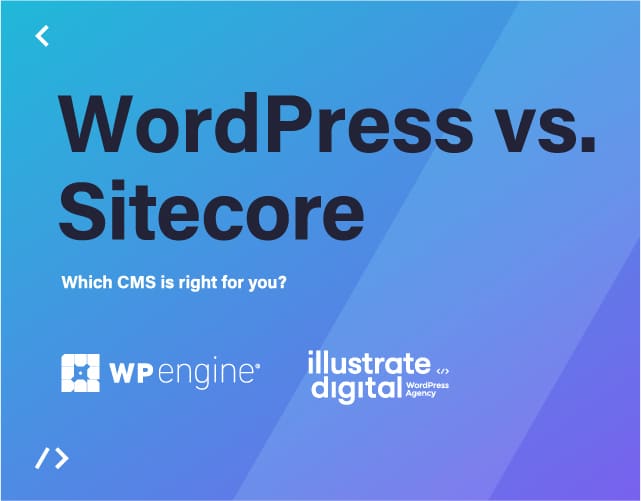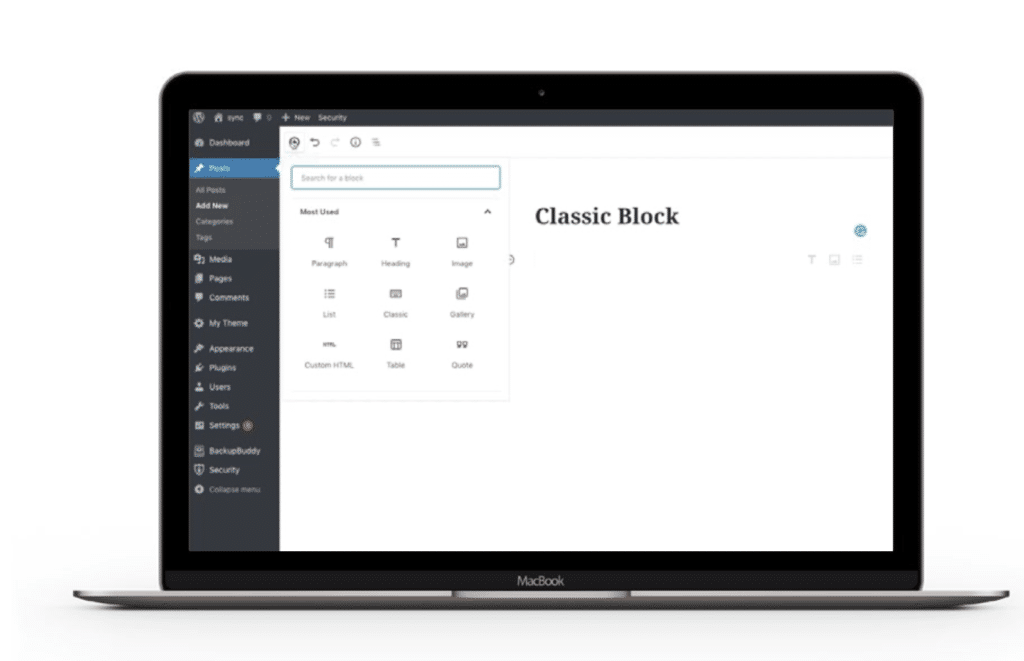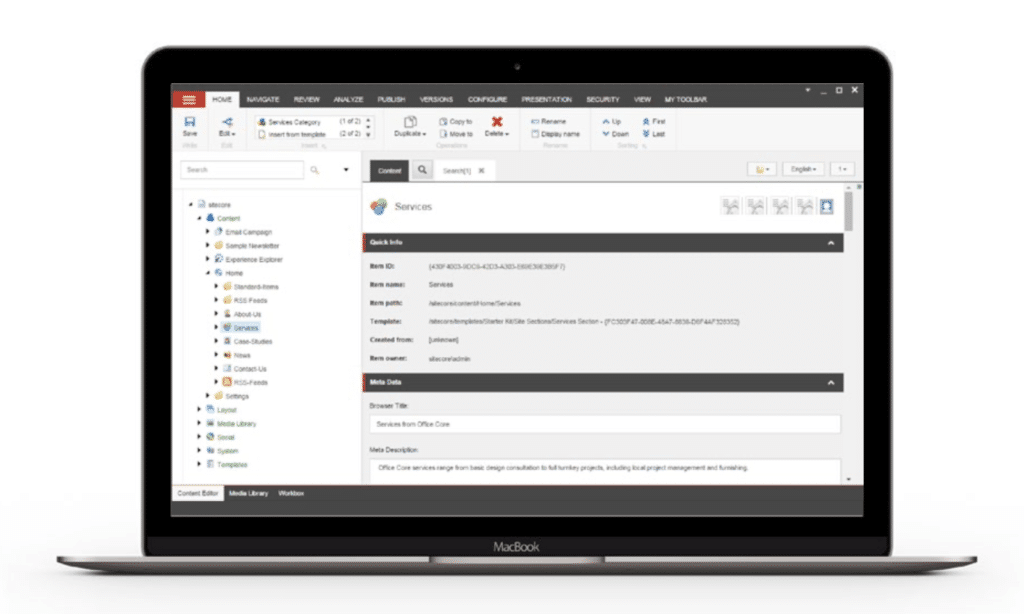

WordPress vs. Sitecore: Evaluating User Experience and Ease of Use
The demands of digital acceleration have prompted businesses of all sizes to reexamine the way they interact with customers and the process for managing those interactions online.
As large enterprise organizations reevaluate their ability to respond to market trends quickly and maximize ROI, the content management systems (CMS) they’ve had place are coming under increased scrutiny.
Historically, businesses with large digital footprints have relied on a proprietary CMS for content management needs, often based on perceived advantages in the areas of security or customizations. While those advantages may have been significant five or 10 years ago, the CMS landscape has widely expanded since, and the options for enterprise content management now include solutions that are more agile and cost-effective than the complex, cumbersome systems of the past.
Finding those agile, cost-effective solutions is key, but as the number of CMS (and other content management) solutions has multiplied, sifting through all of the different choices can be a time-consuming endeavor.
To help narrow the search, this guide, co-authored with WP Engine Agency Partner Illustrate Digital, will help you evaluate the differences between Sitecore, a popular, proprietary CMS, and WordPress, an open source framework that now powers more than 40% of the top 1 million websites in the world by traffic. Download the full report to find out how Sitecore stacks up next to WordPress, or keep reading for a preview.
Download the ebook now to read the full report!
WordPress vs. Sitecore: Evaluating User Experience and Ease of Use
One of the most important factors to consider when evaluating a CMS is overall user experience and ease of use.
At a macro-level, Sitecore is simply more complicated than WordPress, and configuring Sitecore can be an error-prone and frustrating process for even experienced developers.
The platform is so vast, with many different options for configuration, that it’s not uncommon for Sitecore users themselves to be unaware of the extent of their own implementations.
For example, the caching model used by Sitecore is not widely understood by developers. In addition to legacy issues that build up over time, the complicated nature of Sitecore’s infrastructure can slow down performance and make even small deployments a risky endeavor.
These inherent challenges often require resources from multiple teams within an organization—some even create a “Sitecore team,” focused solely on keeping up with the intricacies of the platform—and overall, Sitecore is often viewed as highly functional but also highly developer-reliant.
WordPress, on the other hand, offers a far more straightforward user experience. To gain the full breadth of functionality that’s available with WordPress, it mainly requires staying up-to-date with the most recent version (or relying on a managed provider to help test and update sites as new versions of WordPress become available).
If you’re using a recent version of WordPress, you’re likely benefiting from its most recent features and upgrades, and there are no restrictions as to how you can expand on its use.
With Sitecore, users gain access to different levels of functionality by purchasing a specific product suite (as well as add-ons) to accommodate their digital requirements.
Right off the bat, this tiered approach affects the overall user experience, as there is no “one
Sitecore.” Instead, users must select from specific products and features while potentially requiring an upgrade once they surpass a certain threshold.
Beyond initial setup, the task of designing and building a front end still awaits users of both CMSs (even when using Sitecore’s highest package level), and this too is an area of differentiation between WordPress and Sitecore.
While there’s more detail below on specific content and site creation functionality (content management tools, adaptability/versatility), the major difference to keep in mind is that Sitecore simply requires more technical knowledge than WordPress does, even for relatively minor tasks and updates.
Content creators, who oftentimes sit in the marketing department and who are not proficient in code or technical workflows will likely be unable to self-serve when it comes to many Sitecore functions, potentially adding extra burden to a company’s developer or engineering team.
Conversely, WordPress is renowned for its ease-of-use—by both developers and marketers—and it’s a favorite tool of content creators based on tools and features that speed up web design and content management.
While “developer-heavy” CMSs like Sitecore can eat up valuable time and resources with complicated workflows that slow down content and design, WordPress offers an easier approach to content creation and management, making it easier to go to market and bring new ideas to life faster.
Content Management Tools
One of the most important things to assess when evaluating a CMS is, perhaps unsurprisingly, its tools and features for content management. If creating relatively simple pieces of content such as blog posts or landing pages is too complicated or clunky of a process for a certain CMS, that’s certainly a red flag, and it will likely hamper your larger digital footprint down the road.
WordPress Content Management Features
One of the reasons WordPress is the world’s most popular CMS is because it offers a straightforward, intuitive approach to content management that’s easy for a wide variety of users. That doesn’t mean WordPress lacks depth when it comes to content management—far from it—but it is 100% more accessible out of the box than more technical options like Sitecore.
Editing content on a page-by-page or post-by-post basis is significantly easier with WordPress, based in no small part on the block-based, Gutenberg editor (seen below), which became the default editing experience in WordPress version 5.0.

Gutenberg frees users from a ton of manual code creation with a modular approach to design that’s become the new standard for easy customization and management.
Content creation with Sitecore is less straightforward, and it doesn’t offer the same level of per-page usability as WordPress (which will soon offer even wider usability with the introduction of Full Site Editing).
Overall, WordPress provides key content management benefits with:
Content blocks – WordPress offer you the ability to create custom blocks or choose from a growing library of unique, pre-existing blocks for a faster content workflow that can be used multiple times on any page across your website with brand continuity.
Agile post management – create custom post types and quickly publish new content that brings to life everything from new products, announcements, brand campaigns, and more.
Optimized content structure – the structure of content types and URLs in WordPress are specifically geared towards usability and SEO.
Sitecore Content Management Features
Sitecore remains a prevalent choice at the enterprise level where content management is often less about ease of setup and more about capabilities for deeper personalization and customization.

Indeed, Sitecore provides out-of-the-box benefits in this area (dependent on product package). With available features and capabilities tied to four different pricing levels, users are able to gain access to a range of pre-built features, including:
- Content reuse – for duplication and quick editing of existing pages.
- Content archiving – for back-ups and versioning.
- Sitecore experience accelerator (SXE) – for the simultaneous reuse of templates, layouts, and components across teams and sites.
All that said, the above functionality is not as straightforward as some users might like. Creating simple posts using Sitecore requires managing a “content tree,” adding “siblings,” and ensuring that associated content remains relevant when changes occur.
This setup can feel both rudimentary and complicated at once, and users who are less proficient using Sitecore can cause a wide range of issues by overlooking even minor details.
Sitecore has a slightly better toolkit of “day-one features” for regularly managing and customizing content, as well as deeper personalization, which enterprise brands often value, nonetheless, it’s both costly and technically complex.
This isn’t to say that deeper personalization and customization isn’t possible with WordPress —it can in fact rival Sitecore when it’s put to effective use. A WordPress specialist agency that is well-versed in UX, such as Illustrate Digital, can elevate far beyond WordPress’ built-in functionality, and combined with WP Engine’s enterprise WordPress hosting platform, even the largest digital footprints can realize greater agility and cost savings by leveraging WordPress.
Overall, WordPress will almost always provide greater value and better Return on Investment (ROI) for small or medium-sized businesses. As it’s evolved over the years, WordPress is also now highly capable of accommodating enterprise-level sites, as well as the needed scale and functionality that comes with them. If you’re looking for an enterprise solution, WordPress or Sitecore can likely both meet your needs, the deciding factor will be cost, what’s installed from day one, and what you’re willing to further develop to meet your digital requirements.
Download the full ebook to find out more or chat with a specialist for answers to your questions!












